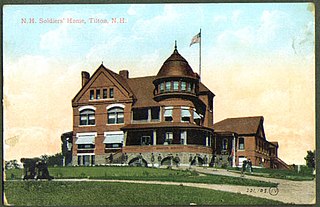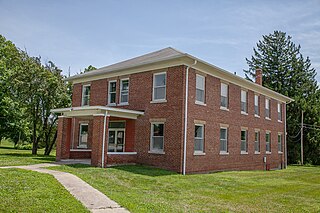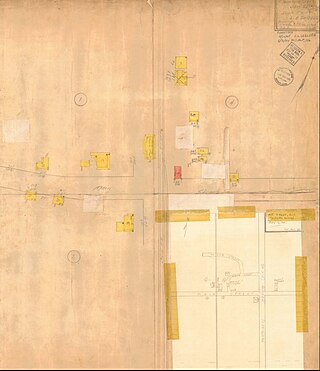
Wetumpka is a city in and the county seat of Elmore County, Alabama, United States. At the 2020 census, the population was 7,220. In the early 21st century Elmore County became one of the fastest-growing counties in the state. The city is considered part of the Montgomery Metropolitan Area.

Troy is a city in and the county seat of Pike County, Alabama, United States. It was formally incorporated on February 4, 1843.

An old soldiers' home is a military veterans' retirement home, nursing home, or hospital, or sometimes an institution for the care of the widows and orphans of a nation's soldiers, sailors, and marines, etc.

Rock Creek Cemetery is an 86-acre (350,000 m2) cemetery with a natural and rolling landscape located at Rock Creek Church Road, NW, and Webster Street, NW, off Hawaii Avenue, NE, in the Petworth neighborhood of Washington, D.C., across the street from the historic Soldiers' Home and the Soldiers' Home Cemetery. It also is home to the InterFaith Conference of Metropolitan Washington.

Oak Woods Cemetery is a large lawn cemetery in Chicago, Illinois. Located at 1035 E. 67th Street, in the Greater Grand Crossing area of Chicago's South Side. Established 171 years ago on February 12, 1853, it covers 183 acres (74 ha).

Caspar Buberl was an American sculptor. He is best known for his Civil War monuments, for the terra cotta relief panels on the Garfield Memorial in Cleveland, Ohio, and for the 1,200-foot (370 m)-long frieze on the Pension Building in Washington, D.C.

The Confederate Memorial State Historic Site is a state-owned property occupying approximately 135 acres (55 ha) near Higginsville, Missouri. From 1891 to 1950, the site was used as an old soldiers' home for veterans of the Confederate States Army after the American Civil War. The Missouri state government then took over operation of the site after the last veteran died in 1950, using it as a state park. In 1981, a cottage, a chapel, and the Confederate cemetery were listed on the National Register of Historic Places as the Confederate Chapel, Cemetery and Cottage. The chapel was moved from its original position in 1913, but was returned in 1978. It has a tower and a stained glass window. The cottage is a small wooden building, and the cemetery contains 723 graves. Within the cemetery is a monument erected by the United Daughters of the Confederacy which is modeled on the Lion of Lucerne. In addition to the cemetery and historic structures, the grounds also contain trails, picnic sites, and fishing ponds.

Pewee Valley Confederate Cemetery is one mile from the old Kentucky Confederate Home site. The National Register of Historic Places lists the cemetery and separately an individual monument within it, the Confederate Memorial in Pewee Valley, as part of the Civil War Monuments of Kentucky MPS. It is the only cemetery for Confederate veterans, 313 in total, that is an official state burying ground in Kentucky.

Mountain Creek is an unincorporated community in southeastern Chilton County, Alabama, United States.
Confederate monuments and memorials in the United States include public displays and symbols of the Confederate States of America (CSA), Confederate leaders, or Confederate soldiers of the American Civil War. Many monuments and memorials have been or will be removed under great controversy. Part of the commemoration of the American Civil War, these symbols include monuments and statues, flags, holidays and other observances, and the names of schools, roads, parks, bridges, buildings, counties, cities, lakes, dams, military bases, and other public structures. In a December 2018 special report, Smithsonian Magazine stated, "over the past ten years, taxpayers have directed at least $40 million to Confederate monuments—statues, homes, parks, museums, libraries, and cemeteries—and to Confederate heritage organizations."

A Ladies' Memorial Association (LMA) is a type of organization for women that sprang up all over the American South in the years after the American Civil War. Typically, these were organizations by and for women, whose goal was to raise monuments in Confederate soldiers honor. Their immediate goal, of providing decent burial for soldiers, was joined with the desire to commemorate the sacrifices of Southerners and to propagate the Lost Cause of the Confederacy. Between 1865 and 1900, these associations were a formidable force in Southern culture, establishing cemeteries and raising large monuments often in very conspicuous places, and helped unite white Southerners in an ideology at once therapeutic and political.
Edgar A. Bras was a United States soldier who fought with the 8th Iowa Volunteer Infantry Regiment during the American Civil War. He received his nation's highest award for valor, the U.S. Medal of Honor, for the bravery he displayed during the Battle of Spanish Fort in Alabama on April 8, 1865. That award was conferred on June 8, 1865.
The Civil War Trust's Civil War Discovery Trail is a heritage tourism program that links more than 600 U.S. Civil War sites in more than 30 states. The program is one of the White House Millennium Council's sixteen flagship National Millennium Trails. Sites on the trail include battlefields, museums, historic sites, forts and cemeteries.

There are more than 160 monuments and memorials to the Confederate States of America and associated figures that have been removed from public spaces in the United States, all but five of which have been since 2015. Some have been removed by state and local governments; others have been torn down by protestors.

At least four widows of veterans of the American Civil War are known to have survived into the 21st century. All were born in the 20th century and married their husbands while the women were still young and the men were in advanced age. This practice was not uncommon at the time due to the possibility of receiving pensions as dependents of Civil War veterans; the pensions were known for their generosity. Some of these unions were in name only, while others lived together as married couples.












